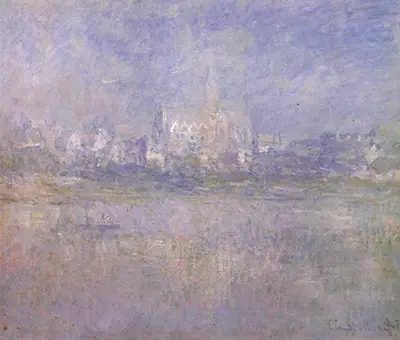A favourite subject indeed in Monet's paintings during his stay at Vétheuil. Deep with astutely defined colour contrast across the canvas, Claude Monet’s Vetheuil in the Fog, enthrals a spectacular production into a foggy morning on the water. Monet makes use of a blue tonation throughout the painting further amplifying and reflecting the blue of the water and the sky, more to the meaning, giving impression and shrewdness; that with the dawn of the fog all things blend into one. Claude Monet’s Vetheuil in the Fog indeed is an excellent astute touch exceptionally offering subtle, albeit shrewd distinct impressions of figural forms throughout the artwork, an excellent example of Monet’s exquisite impressionist style intricately perfected over the years, as was evidently characteristic in many of his paintings.
Vetheuil in the Fog depicts a grand splendour. Across the canvas, it is observable that Claude Monet prudently applied his brush in hastened technique as the outlines indicate attempts to encapture the beauty of the moment, the exact image, carefully blending all the aspects before the gleaming beams of the sunlight spread shifted or faded away altogether. Claude Monet's emphasis on capturing the fleeting changes in the beautiful natural world was an all too central aspect of his aptitude. Capturing the ephemerality of nature and preserving these transient and stunning moments within a picture plane, crystallising this momentary perception, optical nourishment for the soul forever. A glance afar the astral plane, a view beyond compare.
Claude Monet 1840 to 1926, founder of the impressionism style of painting, was one of the most influential and monumental landscape painter in Art History. Born in Paris, Monet was subsequently enrolled in the studio of Glenyre, where he met the likes of Sisley, Renoir, and Bazille, who later on became core founders of the Impressionist group. In 1878, Claude moved with his family to Vetheuil, a town in Northern France. During his stay, they temporarily lived with an affluent magnate who later on became Monet’s patron.
But it was during this time, and his stay at Vetheuil that he made one of his most excellent works, Vetheuil in the Fog a masterpiece illuminated by carefully placed short strokes of colour in favour creating a contrast effect making the painting more vivid, relishing, and breath-taking to the eye. Embracing Alfresco painting, Monet broke the outgoing tradition of portraying a subject by literally resonating the canvas conveying the transient details from fleeting effects of atmosphere to the time of day in depicting the moment, not forgetting a touch of pizzazz in illuminating colour and light.
Carefully eliminating black and grey spread from his palette, representing colour in valour like a prism, breaking it down into its spatial units, often painting a series of the same scenery under different ambiences from light, to weather conditions, amongst other aspects. Claude Monet indeed successfully brought the ambient study of transient effects of natural light, with respect to the totality of the surrounding, and how they blend into one, to its most refined expression and proportions, ultimately rising to become a forerunner of 20th-century impressionist revolution and embracement of modernism.


